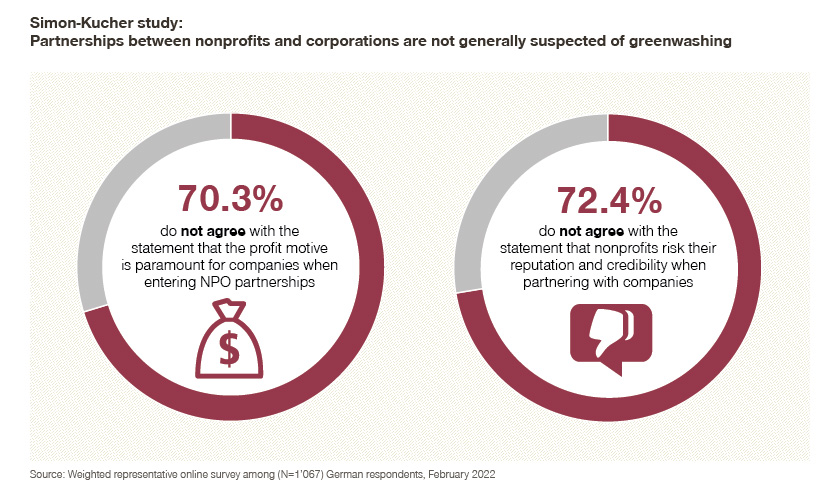Collaborations between nonprofits and corporates – are they simply greenwashing? Our recent study reveals: Partnerships between private companies and nonprofit organizations are generally perceived as credible by the population. But what is actually important to keep in mind when it comes to nonprofit-corporate alliances? 3 key steps for NGOs and nonprofits.
Results from a recent study by Simon-Kucher and Partners debunk the greenwashing myth. Teaming up with a nonprofit to achieve a common goal doesn’t have to raise suspicions of profit or publicity grabbing. Rather, the study shows that over 70 percent of participants are receptive to nonprofit-corporate alliances – with the younger generation in particular recognizing the diverse reasons behind them.

Similarly, nonprofits must no longer risk their reputation or credibility when exploring corporate partnerships as an important source of income. Wider acceptance among the population combined with a growing focus on corporate social responsibility creates new opportunity in a tough fundraising environment. Last year in the US alone, corporations gave over 20 billion dollars to nonprofit organizations – and this figure is only likely to grow.
We have identified several key challenges that prevent nonprofits from reaping the full benefits of corporate partnerships:
Greater potential, tougher negotiations
Corporate interest in nonprofit partnerships has increased dramatically in recent years thanks to greater employee expectations around CSR. Over 90 percent of employees believe companies must lead with purpose and 88 percent no longer consider it acceptable for companies to make money at the expense of society. As a result, companies are investing heavily in their CSR departments, with an increasingly professionalized approach, more experienced negotiators at the helm, and higher demands around what a nonprofit should deliver.
Offerings and prices based on individual or historical relationships
Nonprofits, on the other hand, often lack relevant data and insights into their partners’ needs, or even their own offering. Prices may be determined based on an account manager’s negotiating skills, their existing relationship with a specific contact person, or simply their gut-feeling on the day. Meanwhile, the lack of a clear price list and packaging structure means that many valuable extras and services are not calculated or are thrown in for free, without considering different segment needs or a corporate’s true willingness to pay.
Non-financial opportunities left untapped
It is not uncommon for nonprofits to deliberately limit their income from private sector partnerships to a certain strategic threshold in order to avoid becoming too dependent on one income source. As explained in this guide to donor retention, nonprofits need diverse strategies to keep individual givers onboard in the long term. However, this approach overlooks a multitude of strategic opportunities that the regular corporate donors can provide beyond financial support. Such benefits include more stable and predictable funding through long-term contracts, increased visibility through the partner’s communication channels, use of the partner’s technical expertise, and the ability to scale faster thanks to leverage with enabling institutions, just to name a few.
A systematic approach to corporate partnerships: 3 key steps for nonprofits
Only through a well-defined strategy can nonprofits enter partnerships that truly work both ways. Of course, there is no one-size-fits-all solution, and larger strategic partnerships will require a greater degree of customization than smaller ones. But regardless of size, in our projects we identified three proven steps that nonprofits can follow to ensure a fair level of value is unlocked for both the corporate and the nonprofit organization.
1. Quantify corporate partners’ value drivers and willingness to pay
Nonprofits frequently underestimate the value they bring to corporate partnerships. Identifying and quantifying the added value of their different services is a crucial first step. What are the specific needs and preferences of different partners and partner segments? How can the value drivers and willingness to pay be quantified? Where are the nonprofit’s competitive strengths and weaknesses? And what is the resulting unique selling proposition?
Example: Answering these questions helped a humanitarian nonprofit in the Netherlands to revise its partnership model. After conducting interviews both internally and with corporate firms, the nonprofit recognized that requirements and willingness to pay differed depending on whether they were dealing with an internal- or external-facing department. They found that Sales and Marketing teams placed high value on services such as use of the nonprofit logo and promotional activities, while HR and Governance being based on employee data sources were more interested in internal trainings and employee engagement factors. Today, the nonprofit’s offering reflects these differing needs in a value-based price list, which is used to structure partnership negotiations and facilitate up-selling.
2. Define a clear and segment-specific value proposition and offering
Nonprofits deliver an extensive range of benefits and services to their corporate partners – from branded email signatures, website banners, and cobranding, to educational materials and webinars, use of ambassadors, and joint development of projects – the list goes on. But the spectrum of choice can become overwhelming for both the corporate and the nonprofit itself, with no systematic way of charging for benefits or steering behavior.
Example: A humanitarian nonprofit in Denmark aimed to address this issue by designing different corporate partnership bundles. It began by defining the cost of delivering each of its services and then conducted surveys and interviews with current and potential partners to understand their behavior, value drivers, and willingness to pay. This helped the nonprofit to design packages that were tailored to target segments and based on a good-better-best logic, with the “best” package offering the full suite of benefits and the “good” offering the
most limited selection. The nonprofit now maximizes its use of limited resources while the value of services is communicated more clearly, encouraging selection of the most valuable package.
3. Communicate the delivered value and defend it in negotiations
Once value is identified, quantified, and presented in the most effective way, it needs to be communicated with just as much preparation. Account teams should enter negotiations fully equipped with an in-depth understanding of their strengths, offerings, and the wide range of benefits they deliver. This requires developing and prioritizing arguments in advance, while exploring ways to deepen the relationship through up- and cross-selling. Internally, there needs to be alignment on an anchor, target, and walk-away price, with a systematic approach for concessions.
Example: This is how an environmental nonprofit in Switzerland was able to transform its negotiations. By defining concession tactics and adopting a value communication approach, it developed a structured approach to enter negotiations for large multi-year partnerships. Today, account teams are supported by a negotiation playbook that creates transparency on the nonprofit’s competitive positioning and helps them to determine deal-specific value drivers and willingness to pay.
Reaping the full benefits of collaborations with the private sector: Succeeding through strategy
Corporate partnerships are gaining wider acceptance among the population and are no longer a taboo topic for nonprofits. Of course, entering such partnerships can consume a significant amount of time and resources, and nonprofits should be conscious of ensuring a fair value exchange.
However, when approached strategically, corporate partnerships enable nonprofits to tap into a larger money pool than only with individual donations and help them to achieve greater financial stability by diversifying income. The corporate brings additional skills and assets to the table such as knowledge, publicity, and contacts, which may be crucial to mission accomplishment. In return, nonprofits have a wide range of benefits to offer their partners – and these benefits need to be identified, quantified, and communicated systematically for corporate alliances to reach their full potential.
